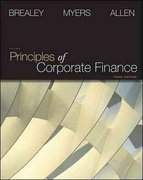Suppose that Treasury bills offer a return of about 6% and the expected market risk premium is
Question:
Suppose that Treasury bills offer a return of about 6% and the expected market risk premium is 8.5%. The standard deviation of Treasury-bill returns is zero and the standard
◗ TABLE 7.9 Standard deviations of returns and correlation coefficients for a sample of eight stocks.
Note: Correlations and standard deviations are calculated using returns in each country’s own currency; in other words, they assume that the investor is protected against exchange risk.
Correlation Coefficients BP Canadian Pacific Deutsche Bank Fiat Heineken LVMH Nestlé
Tata Motors Standard Deviation BP 1 0.19 0.23 0.20 0.34 0.30 0.16 0.09 22.2%
Canadian Pacific 1 0.43 0.31 0.39 0.34 0.17 0.40 23.9 Deutsche Bank 1 0.74 0.73 0.73 0.49 0.68 29.2 Fiat 1 0.66 0.64 0.47 0.53 35.7 Heineken 1 0.64 0.51 0.50 18.9 LVMH 1 0.52 0.60 20.8 Nestlé 1 0.43 15.4 Tata Motors 1 43.0 Visit us at www.mhhe.com/bma 184 Part Two Risk deviation of market returns is 20%. Use the formula for portfolio risk to calculate the standard deviation of portfolios with different proportions in Treasury bills and the market.
( Note: The covariance of two rates of return must be zero when the standard deviation of one return is zero.) Graph the expected returns and standard deviations.
AppendixLO1
Step by Step Answer:





